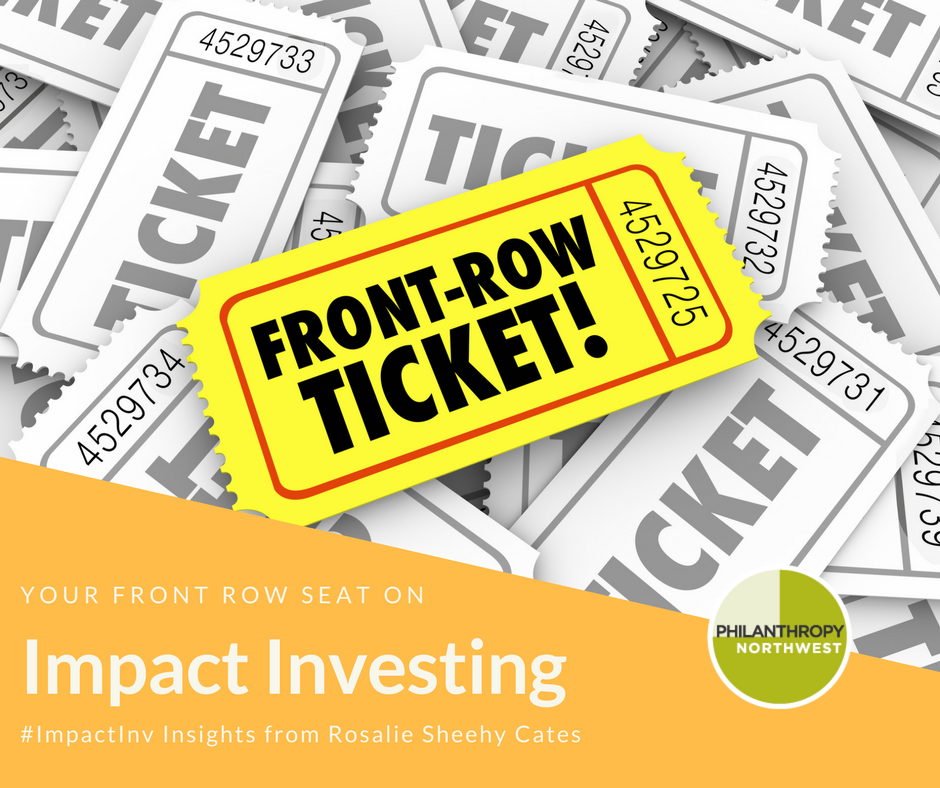
Editor's Note: An Executive in Residence at Philanthropy Northwest, Rosalie works with foundation trustees and executive staff to set up impact investing programs, and to solve investing issues. From this Front Row Seat, she sees some very good ideas. In this multi-part blog series, Rosalie shares observations and insights care of many smart and innovative foundations and financial advisors working to make impact investments in the (mostly) Pacific Northwest region. To learn more, please email Rosalie—she looks forward to hearing from you!

I was a little frustrated. It was a cold winter night and I was entering the Burns Street Bistro in my hometown of Missoula, Montana, for a local investing event.
I had been working that day with a financial advisor to a big foundation. We were reviewing possible impact investments in various asset classes for the foundation’s endowment. But the advisor was skeptical that any of them would meet the foundation’s investment policies. The projected returns were OK—but the managers lacked the experience and track record they required. I felt frustration rise in me as one option after another bit the dust.
I understand and respect the rationale for the foundation investment policies. I am a foundation board trustee myself, overseeing $100 million in the endowment. In that role, I honor our policy, which manages risk by requiring we work with the most experienced managers, running the most successful funds, in industries that have the strongest chance of earning us a market rate of return.
But some days – and this was one of them – I feel like we split too many hairs about risk at investment committee. Our policies essentially say “only the best will do.” There is no room for investments that are likely “good enough.” Those investments just don’t cut it once they are sliced and diced by modern risk assessment theory.
So yes – I was a little disenchanted with the whole impact investing world. But I joined fellow Missoula investors and local farmers at the bistro, located in a food coop in our town’s funky west side. The event was a ‘Pitchfest” sponsored by the Missoula Community Food and Agriculture Coalition (CFAC). Four farmers would pitch us to make small investments in their food enterprises.
CFAC has an ingenious partnership with the giant national mission lender Kiva. As a trusted local broker for Kiva, CFAC helps local farm enterprises complete an initial round of “friends and family” funding. If the farmers make that happen, CFAC qualifies them as Kiva loan candidates and they are featured on Kiva’s website. There they are seen by a huge, international group of lenders looking for small mission loans.
(This is an elegant model, by the way. Who knew you could pair a fully-scaled international investor platform—Kiva—with the deep local wisdom and relationships of a small grassroots farm organization like CFAC? I love this.)
The atmosphere in the restaurant was warm and informal. Lots of friends were there, some from foundations and others who invest as individuals. There was a big table full of good local food, a raffle for frozen local cherries and a table to sign up for Kiva. Kids buzzed around the edges of the crowd.
The pitches soon began. Four different farmers described the investments they needed. One needed to buy a walk-behind tractor. The second wanted to finish a honey processing room and the third was ready to construct a high-tunnel greenhouse. The fourth needed working capital.
All the “pitchers” were female farmers. They showed pictures of their farms, their products, their partners and their kids working with them.
As I considered these enterprises, I felt my earlier frustration with solving the risk puzzle for impact investing give way. Now I was feeling something more like gratitude, seeing the courage of these young farm families.
Risk, I thought. Tell these women about risk. They don’t have two nickels to rub together, but here they are with their babies on their hips, pitching us for $3,000 so they can bust up the food system and take care of the world’s precious soil and water.
Just exactly who in this investment ecosystem is really taking risk?
The surprise of the night was that all four farmers were already fully funded. It seems that Kiva members had fully subscribed each of the Missoula loans within hours of their posting on the website that morning.
There was nothing left for us locals to add. We enjoyed the food and companionship. I won the cherry raffle, and I went home with a happier heart.
My key takeaway:
First, local investing is good for the soul. Direct contact between investors and energetic, idealistic entrepreneurs is healing, reassuring and hopeful.
Second, local investing is good for communities, especially communities of investors. In Missoula, events like the Pitchfest get investors together. Once networked, we find that larger foundation investors will help smaller, less experienced investors to assess risk and make good loan decisions. We also find that investors join forces, as we did in Missoula, on a bigger loan for a local non-profit facility. Now we are considering whether we can help with some significant investment challenges that face Missoula affordable housing developers.
Third, let’s expand our thinking about risk. We don’t have to throw the risk-baby out with the impact-bathwater. But we could take modest steps toward accepting funds and managers with risk profiles that are “good enough” for the very small sliver of the portfolio that they occupy. Then foundations will be taking measured, but completely manageable risk, commensurate with that taken by their investees, in the service of mission.
Front Row Seat is always interested in hearing your solutions to the myriad puzzles that impact investing presents to foundations. Contact Rosalie, and let’s talk! Want more impacting investing information? Rosalie is hosting a special session at our Annual Conference entitled, "A Blueprint for Impact Investing." In a participative format the session will cover how impact investing is implemented by foundations.


